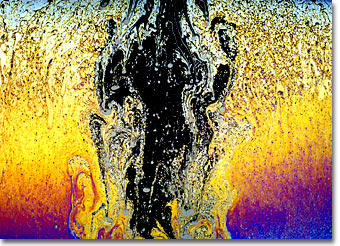Karl E. Deckart
Soap Bubble Gallery: Image Eighteen
German photographer and artist Karl E. Deckart is known for his thorough, precise, and beautiful work both in photography through the microscope and with macro camera systems. This gallery of interference photographs made with soap films is a testament to both Deckart's skill as a photographer and his understanding of the physical phenomena that surround our everyday lives. Presented below is soap bubble image number eighteen in small format. Click on the image to download a larger version.

|
Macrophotography of thin soap films freely suspended on a 4 x 4-inch wire frame was conducted with a Linhof large-format bellows camera system utilizing 4 x 5-inch sheet film and imaged using an apo-macro Nikon large format Nikkor-AM ED 210 mm f-5.6 lens. To prepare the soap film, equal parts of water, glycerin, and dishwasher detergent are thoroughly mixed in a container until a solution containing evenly sized micelles is achieved. A freestanding film is formed by dipping the wire frame into the solution and withdrawing carefully to maintain an even film thickness and avoid disruption of material flow across the frame rails. After suspension, the film was illuminated by a reflected light source positioned a few degrees from the camera system. The light was passed through a diffusion screen to avoid bright spots and provide an even illumination across the field. No polarizers were employed in photomacrography of soap thin films. Image ©1999 by Karl E. Deckart. All rights reserved. |
Soapy materials and cleansing agents have been produced since the dawn of civilization. Ancient records reveal that as early as 2800 BC, Babylonians used soaps to clean textiles, and a purifying agent made from tree bark ash is mentioned in ancient Hebrew literature. Even during the first millennium BC, royals such as the Queen of Egypt did not relax in a tub of bubbles -- however, Cleopatra's famous bathing rituals have been reported to include silky mares' milk and soothing essential oils extracted from plants along the Nile river. Personal use of soap slowly began to spread throughout the Roman Empire, but was accepted in public baths only during the final years. The increasing popularity of soap in ancient Rome is evidenced by the remains of a lava-encrusted soap factory, complete with finished bars, preserved within the City of Pompeii. The Celts have also been credited with the independent discovery of soap as a personal cleansing agent, being thought to have introduced the ritual to the soap-loving British. Today, a wide variety of ingredients are used in fine soaps, including honey, oatmeal, salt, beeswax, sea and land vegetables, and almost every herb imaginable.
BACK TO THE SOAP BUBBLE GALLERY
